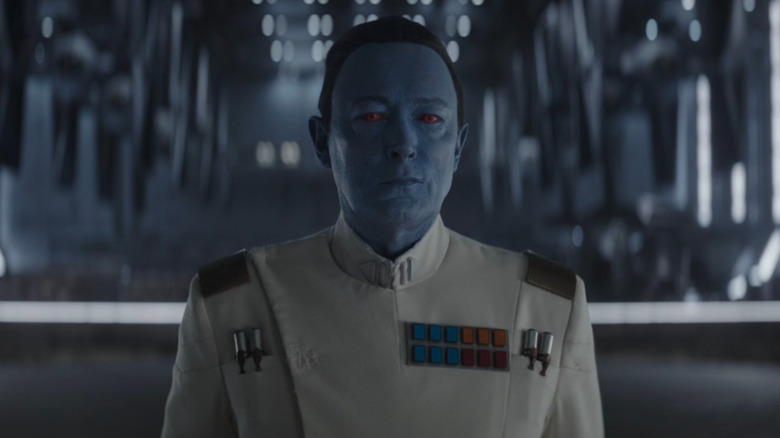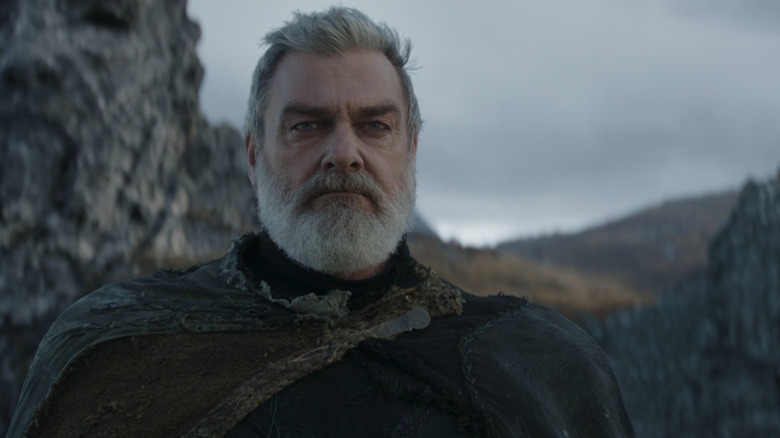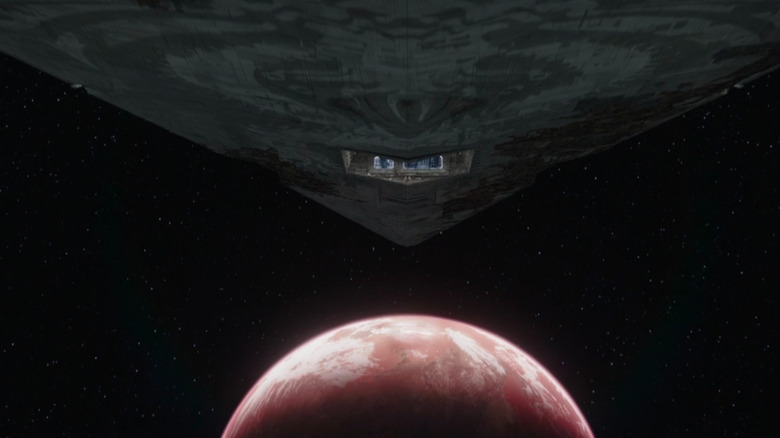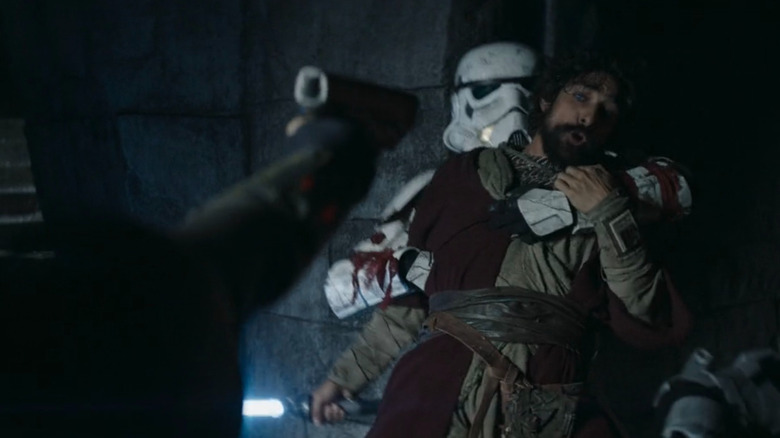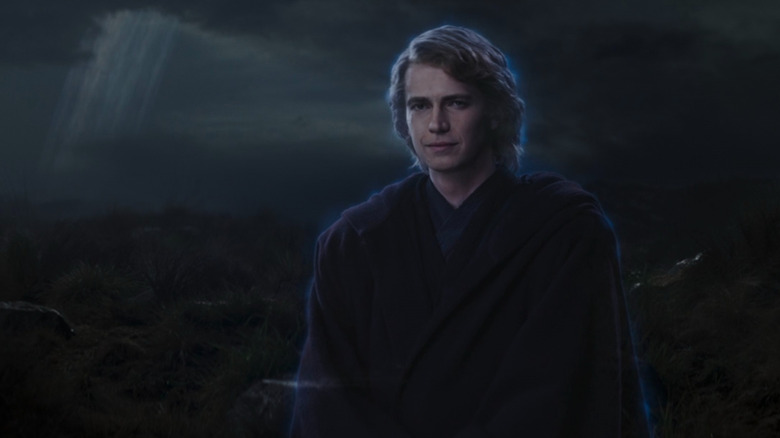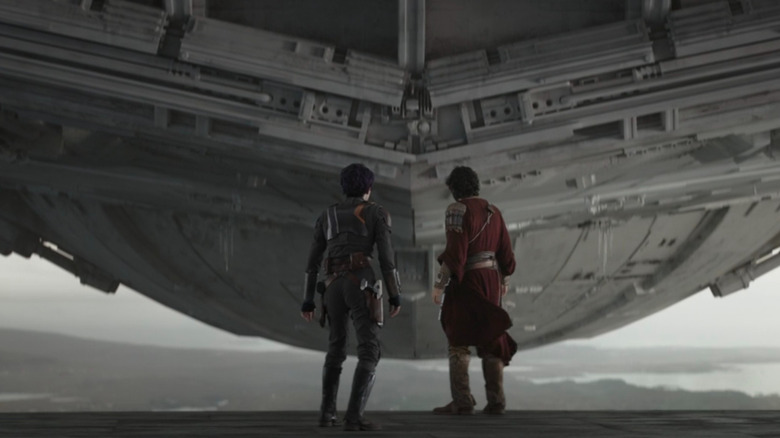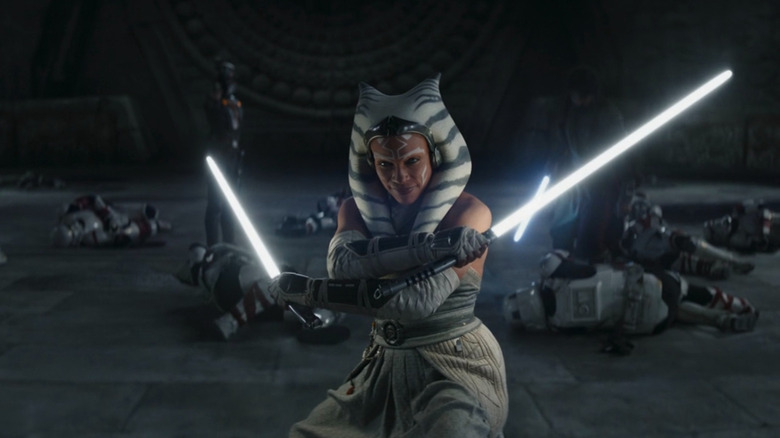Ahsoka's Season 1 Finale Reflects Dave Filoni's Relationship To Star Wars With The Jedi, The Witch, And The Warlord
This article contains spoilers for "Star Wars: Ahsoka" episode 8 — "The Jedi, The Witch, and the Warlord."
As Grand Admiral Thrawn (Lars Mikkelsen) makes his final preparations to return to his own galaxy, Ahsoka Tano (Rosario Dawson), Sabine Wren (Natasha Liu Bordizzo), Ezra Bridger (Eman Esfandi), and Huyang (David Tennant) do their best to stop him. Thrawn, being a far superior tactician, is able to place obstacle after obstacle in their way so that they cannot impede his return. Those obstacles start in the form of Thrawn's Night Troopers, reanimated back from the dead by the magick of the Great Mothers of Dathomir, and culminate in Morgan Elsbeth (Diana Lee Inosanto), who has been imbued with the power of Dathomir and given the fabled blade of Talzin.
As Ahsoka deals with Elsbeth, Ezra and Sabine, race to get aboard Thrawn's Star Destroyer, the Chimaera. Though Ezra is able to make his way aboard, Sabine and Ahsoka are left behind. They try to catch up, but Thrawn makes the jump to hyperspace with both his own Star Destroyer and the Eye of Sion.
As Ahsoka and Sabine adjust to their new life on Peridea, Ezra makes it home to the Rebel fleet, reuniting with his space mom, Hera Syndulla. And Thrawn? He heads to Dathomir. Either to complete his deal with the Great Mothers or raise his own army of the dead, it's unclear.
But the threat of Thrawn in a galaxy far, far away is now very real.
Where's Baylan?
Throughout the entire episode, one thought kept popping up in my head: where is Baylan Skoll (Ray Stevenson)? Shin Hati, too, but more importantly Baylan. When last we saw Baylan, he was seeking some mythical and unknown power and he vanished for the vast majority of this episode. That is until the end. And we see him on a great stone statue, the "Star Wars" equivalent of the Argonath. But instead of the likenesses of Isildur and Anárion, we are treated to the visages of Father, Son, and Daughter, the Force gods of Mortis, first introduced on "Star Wars: The Clone Wars." They were part of a bizarre planet that was a nexus of the Force, which has been a running theme in the background of this season.
We see now that Baylan Skoll is seeking something far more powerful and he is deadly serious. How did he learn about the Force gods? How did he know of the things to look for? Those are interesting questions and how we learn answers to them will be significantly complicated. It's obvious that Baylan Skoll is planned to be an important character going forward, but there's no telling how those stories will be told because Ray Stevenson passed away unexpectedly before the show could air.
Another big question is whether or not these questions will be answered in a future season of "Ahsoka." Or in Dave Filoni's promised "New Republic" movie. It might be a long time before we get an answer.
Thrawn's return
Thrawn has been thwarted twice now in embarrassing ways by the machinations of the Force. The first time was at the Battle of Attolan in the third season of "Star Wars Rebels." Kanan Jarrus provoked the involvement of the Bendu, an ancient creature of the Force who follows neither the light nor the dark.
The second time was at the Battle of Lothal, Thrawn's last engagement during the Galactic Civil War. This was where Ezra Bridger called down the purrgils and sent him into exile in the first place. The Force was the one thing Thrawn's tactical mind couldn't account for. And now, he's learned from it and has become far too powerful. It's going to take everything the New Republic has to put down his threat.
But why has he gone to Dathomir? The coffins or cargo containers were the property of the Great Mothers. Are these the bodies of their fallen sisters come to repopulate the planet with zombies? Or is it somehow to create another undead army for Thrawn? Whatever his plan, it could spell certain doom for a divided New Republic. The "Ahsoka" finale provides no answers, only questions.
Enter the Death Troopers
One of the most interesting things about this episode is the introduction of the undead Night Troopers. We knew, from "Star Wars: The Clone Wars," that the Nightsisters could resurrect the dead to fight as an army. This was their last line of defense when the Separatist forces led by General Grievous committed genocide and eliminated virtually all of the Dathomiri witches.
This is the first time we've seen that they can do this with people that aren't Dathomiri. But it also makes one wonder if they were already undead. Thrawn calls them Night Troopers — could they have already been dead and animated by the Great Mothers? It's certainly an interesting question.
The other thing this seems to reference is the Legends book "Death Troopers," where Han Solo and Chewbacca have to fend off an entire prison ship and Star Destroyer full of undead Stormtroopers. It's a great read and worth revisiting, especially this Halloween season.
It was actually a funny in-joke to see that the two "boss" level troopers at the end were in Death Trooper armor, first introduced in "Rogue One: A Star Wars Story."
Anakin's ghost
For those who think the ghost of Anakin Skywalker's reimagined appearance in "Return of the Jedi" was one of the best changes George Lucas made — people like myself — we got the thing we've been waiting for since the announcement of the sequel trilogy. As Anakin Skywalker watches over his former apprentice, he offers a smile and leaves not a dry eye in the house.
It's such a perfect moment. For a season of television that offers us more questions and setup than answers and payoffs, it is an emotional end for us to hang on to.
Details to watch out for
There were a few great nods to past "Star Wars" installments, like the use of Com-scan. It's not something that's been talked about in a while, but it's a system on Star Destroyers and was first introduced in "The Empire Strikes Back." As far as I can remember, this might be the only time it's been mentioned in live-action since.
Fans of "Star Wars: The Clone Wars" will instantly recognize the magickal blade that Morgan Elsbeth is given. The Blade of Talzin is, quite literally, the blade of Mother Talzin, who led the Witches of Dathomir during the Clone Wars. She used it to fight off Mace Windu in the season 6 episode "The Disappeared: Part II."
As for Thrawn's tactics, his propensity to bombard the surface of a planet was a move he used in the Battle of Lothal and what forced Ezra's hand into surrendering. Granted, that was what allowed him to defeat Thrawn, but it worked. At least for a time.
But perhaps the biggest Easter egg in this episode, and the most important, is the appearance of a convor. These bird-like creatures managed to find themselves appearing anywhere Ahsoka had a strong connection to the Force on her destined path. When they appeared in "Star Wars Rebels," Dave Filoni marked their appearance by saying in an interview with IGN:
"In some ways, I could say that it's a messenger, it's an observer. It is definitely something. And ... I would rather have fans debate — but I would suggest ... that whatever that thing is an avatar of has actually appeared in the animated 'Star Wars' universe before. So decrypt from there."
The Jedi, the Witch, and the Warlord
This entire season has offered riddles and raised questions and answered very few, leaving some to wonder what is going to happen in the future and how we're going to see future installments of the story. Thrawn has returned and is now a danger to the New Republic. I imagine we'll see some elements and threads of the story followed in "The Mandalorian" season 4. We'll probably see a second season of "Ahsoka." Something tells me all the threads will come together in Dave Filoni's "New Republic" movie.
But I think there's a clue buried in the title of this episode. "The Jedi, the Witch, and the Warlord" feels like an obvious homage to "The Lion, the Witch, and the Wardrobe," by C.S. Lewis. In it, a group of children become kings and queens in a fantasy land by stepping through a portal in a wardrobe. Add that thematic hint to Baylan Skoll's discovery at the end of the episode and we might already know the key to discovering how Ahsoka gets back to her own galaxy.
I can see where some people might feel dissatisfied with this ending to the series. It's a big cliffhanger and there's no indication when it will be followed up on. But it's a hell of a setup, right? People might also take issue with Sabine finally being able to tap into the Force. I've already explained why that fits perfectly into the canon, but I also wonder if there's another layer to it. In "The High Republic: Path of Vengeance," a number of individuals who were mildly sensitive to the Force could suddenly manipulate it when they were on a mysterious planet strong in the Force. Could Peridea be similar to that?
The sprawling nature of Star Wars and its deeper meaning
Director Rick Famuyiwa brought his A-game to this episode, as did composer Kevin Kiner. The latter's music for the back half of this season has been some of the best "Star Wars" music ever composed. He's as important to "Star Wars" as John Williams and I don't think that's up for debate.
This episode left me in tears and wondering what's going to happen next, but I think that comes from my deep investment in these characters and their continuing stories. For those who aren't as connected, I wonder how exciting this show really is. Are they merely invested in Thrawn's return and the fate of the New Republic? Or will they go back and enjoy the cartoons? It makes one wonder how much these episodes and series need to stand alone in the sprawling "Star Wars" universe that becomes deeper and deeper with every installment.
"Ahsoka" is ultimately about overcoming your past and doing the right thing — as all stories about Jedi might be. But it's also about trusting those around you even when they challenge you, and it's about doing things even though you know they're hard. Sabine's arc on this show resonated quite a bit with me. So did Ahsoka's. Ahsoka had to shed the fear of the darkness within herself and the worry that she would become Anakin, which is why Thrawn threatens her with that in his final missive to her. He's goading her — playing a mind game. And it could well work.
Filoni really understands the mythical and mystical Force in the franchise and it's no wonder. Look who his master was. And when you think of George Lucas's retirement from "Star Wars," it makes one wonder how much commenting Dave Filoni is doing here. Is Lucas as Anakin at the end there with Filoni as Ahsoka? And is Sabine representative of Filoni's struggles to gain a mastery in "Star Wars?"
I'd like to think it is.
